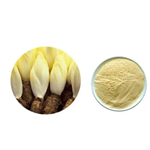Chemical Properties
Chicory is an annual or perennial herb, growing up to 50 cm high. It is indigenous to Europe, India and Egypt. The
plant exhibits leaves stemming directly from the root, similar in shape to those of the related dandelion, but with numerous showy,
blue flowers. There are two principal types: the Brunswick variety has deeply cut leaves and spreads horizontally, and the Megdeburg
variety has undivided leaves and grows erect. The bright blue flowers bloom from July to September. The dried root is the primary
part utilized. Leaves are also used. Chicory has a bitter, tonic flavor.
Chemical Properties
Soluble chicory extract is the product consisting of the dried solids prepared from a water extract or water extracts of
chicory. Also see Chicory.
Occurrence
Chicory is a perennial found in Egypt, India, and the United States.
Uses
Chicory is used as a diuretic and laxative, a coffee substitute, a sedative, an appetite stimulant, and a treatment for cancer. It can be found in many tea product formulas. Chicory is a very mild herb used for its bitter properties, mostly as a tonic.
Definition
Extractives and their physically modified derivatives. Cichorium intybus, Compositae.
Essential oil composition
Chicory flowers contain cichorin (6,7-dihydroxycoumarin-7-glucoside). The root contains up to 8% inulin,
a bitter principle consisting of 1:3 protocatechuic aldehyde to inulin, as well as lactucin and lactucopicrin.* The root contains a
large number of steam-distillable aromatic compounds. Acetophenone provides the characteristic chicory aroma.
Taste threshold values
Taste characteristics at 0.5%: sweet, coffee, caramellic and brown.
